
Table of Contents
Even though breastfeeding is natural, it can be time-consuming to learn this process. With practice, it gets easier for both the mom and the baby. However, in the beginning, latching and positioning can be tricky for a first-time mom. Understanding how to hold a baby the right way and getting them to latch and then sustaining the latch throughout the nursing session is not always easy. It takes a lot of trial and error to find a position that works well for both the mother and the child.
To get extra comfy during breastfeeding sessions, play around with these breastfeeding positions to determine what works best for you.
6 Best Breastfeeding Positions
Now, every mother won’t find the same position effective or comfortable, you have to go through some trial and error and try different breastfeeding positions as we mentioned earlier. Here are some breastfeeding positions:
1. Cradle hold
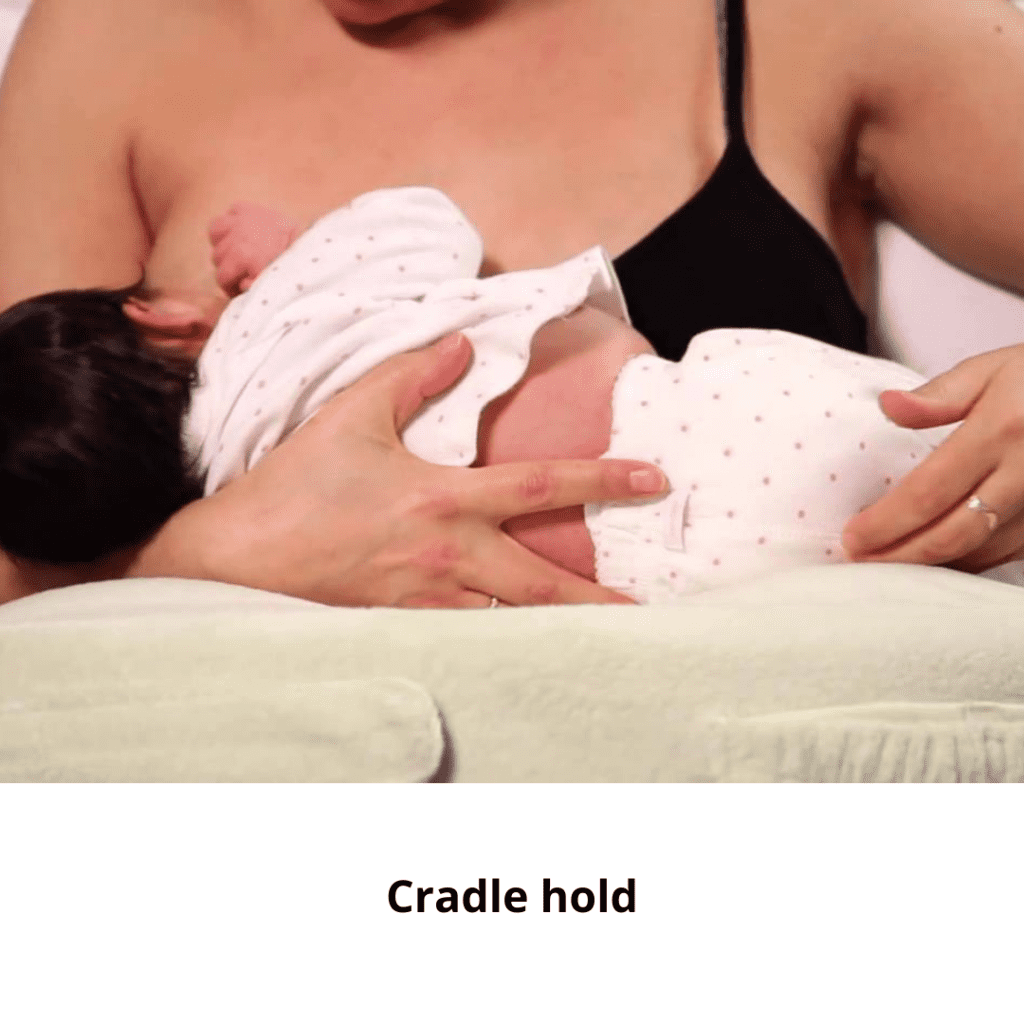
It is a classic breastfeeding position where the baby’s stomach is against the mom’s body.
To do this position:
- Hold the baby so that its stomach is pressed up against your body
- Support it with the hand that is on the same side as the breast from which the baby is feeding
- Keep the baby’s head aligned with the rest of the body so that they don’t strain their neck
- Also, you can use a nursing pillow to support your elbow to make the feeding session more comfortable
A few moms find this position difficult with a newborn. If the mom uses this position, it can get progressively harder to hold this position as the baby grows.
2. Cross-cradle hold
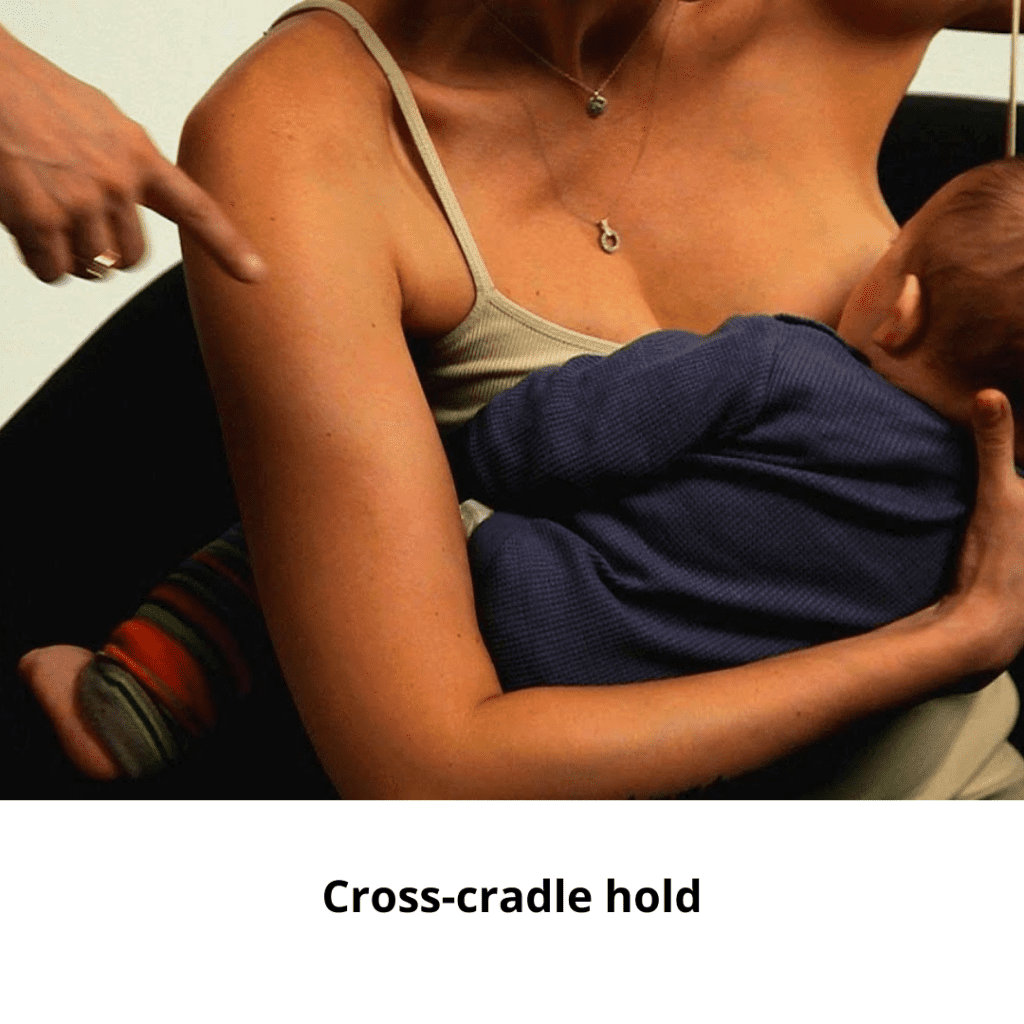
This position is the best for newborns as they can latch easily. The cross-cradle position is almost similar to the cradle hold position, but the mom has to use the opposite arm to support the baby.
For this position, you have to:
- Hold the baby and push them against your stomach while keeping their body aligned.
- Reach with the arm opposite to the breast from which the baby is feeding and supporting their head, allowing their bottom to rest on your forearm.
This position can be difficult at first but with time it gives the mom more control over the baby’s latch. It is also helpful for babies who struggle with a latch.
3. Reclining or Lying Back
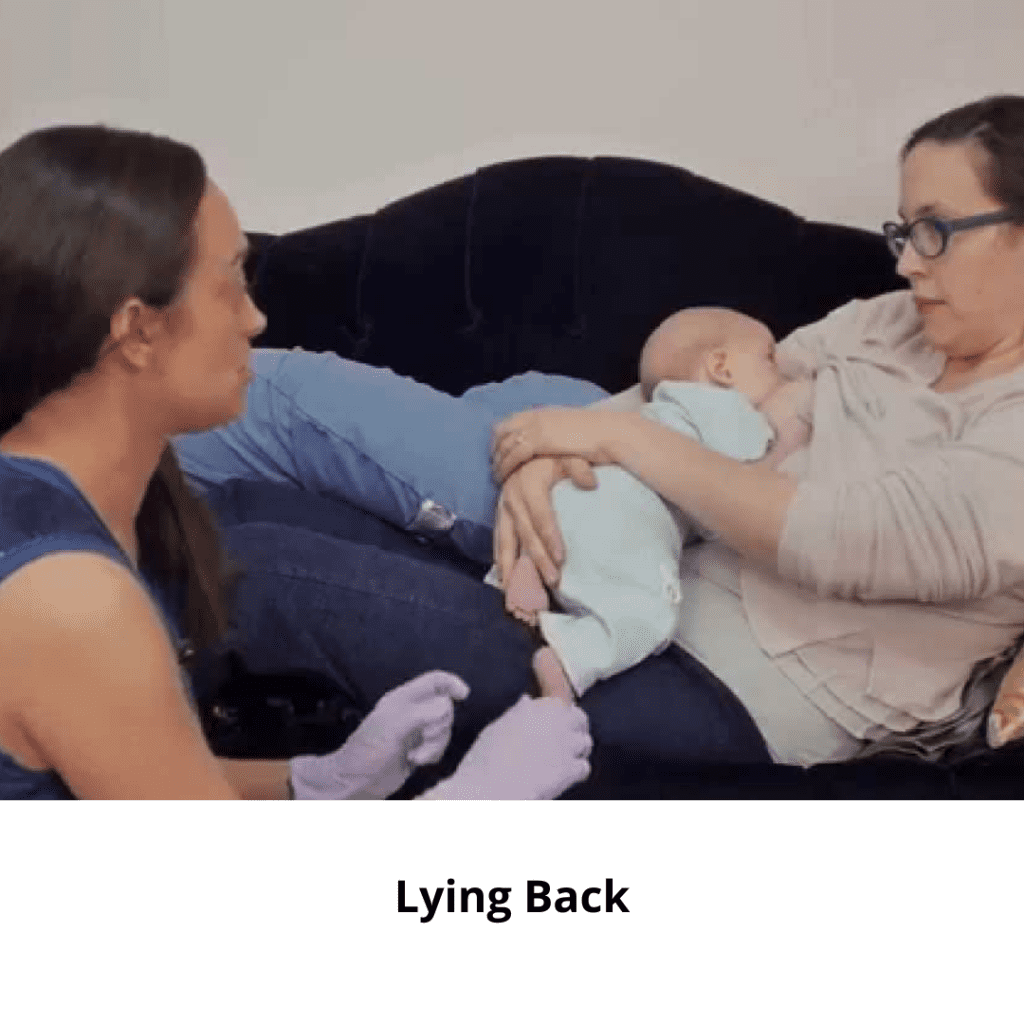
The reclining or lying back breastfeeding position is also known as the biological nursing as it provokes the baby’s instinctive feeding reflexes. Also, it is more comfortable for the mom.
When you start in this position, it may require some shuffling at first but once you get in the proper position, it is very comfortable. It is really helpful for moms who are struggling with muscle pain or if they are recovering from childbirth or surgery.
To hold the baby in this position:
- Find a comfortable chair or a lounge that supports your neck and head. If you can find a reclining chair, that’s super comfortable
- Place the baby’s stomach on your chest and hold their head at your breast level
- Make sure that the baby’s nose is not covered and their neck is straight
- The baby might find the breast themselves, but help them as much as possible
Some moms place the baby upright, with their head up and toes down. Other moms find it comfortable with their baby resting on their bent arm. Again, experiment with the different positions and find the one that works for you.
4. Sitting Baby Position
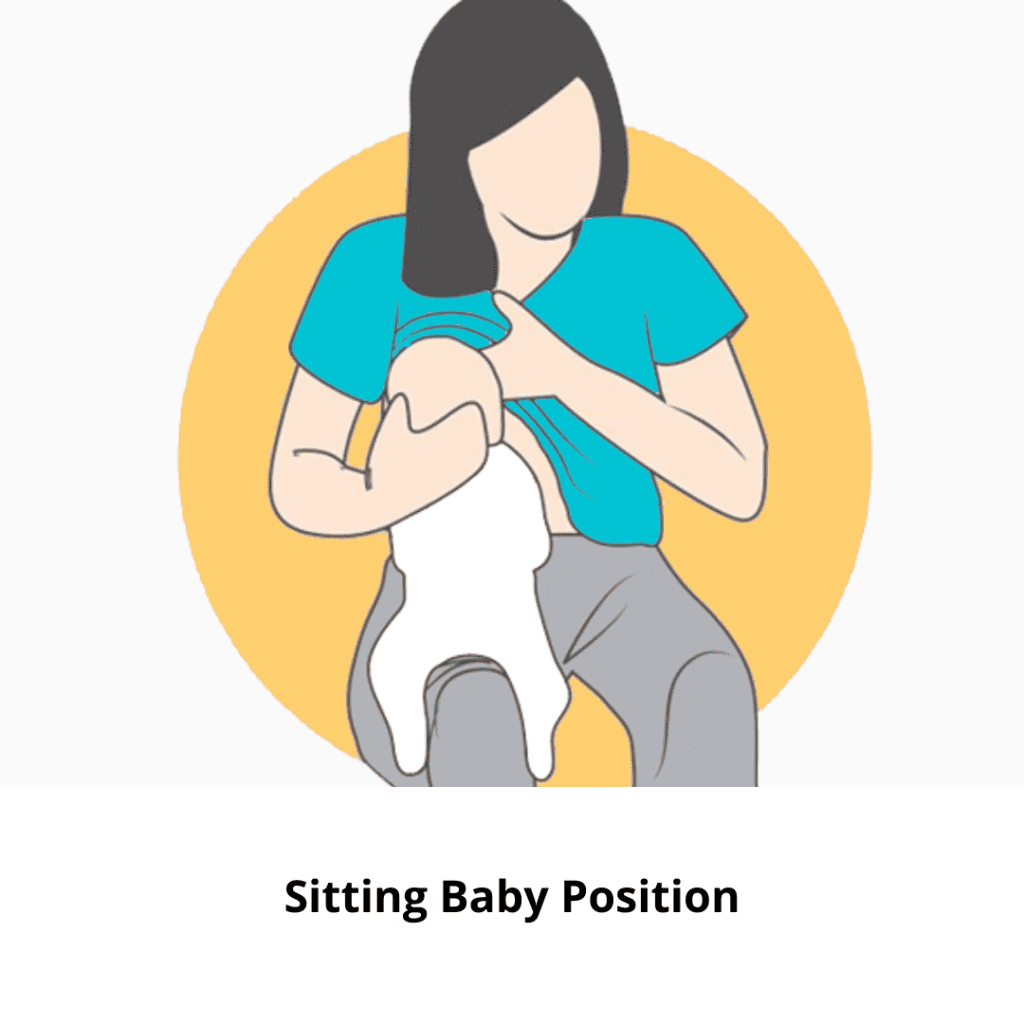
When the baby is old and strong enough to hold their head upright, you can use the sitting baby breastfeeding position. It works well if you are traveling and babies that don’t like being held for long times may also like this position.
To use this position:
- Sit upright and help the baby sit upright as well. Small babies can recline on your somewhat bent arm. Older babies do better as they are sitting completely straight and their legs hug either the left or right side of their stomach.
- Hold the baby’s neck and back until they can sit on their own
- Make sure the baby’s back and neck are aligned
- Ensure that the baby’s nose is not covered
5. Side-lying
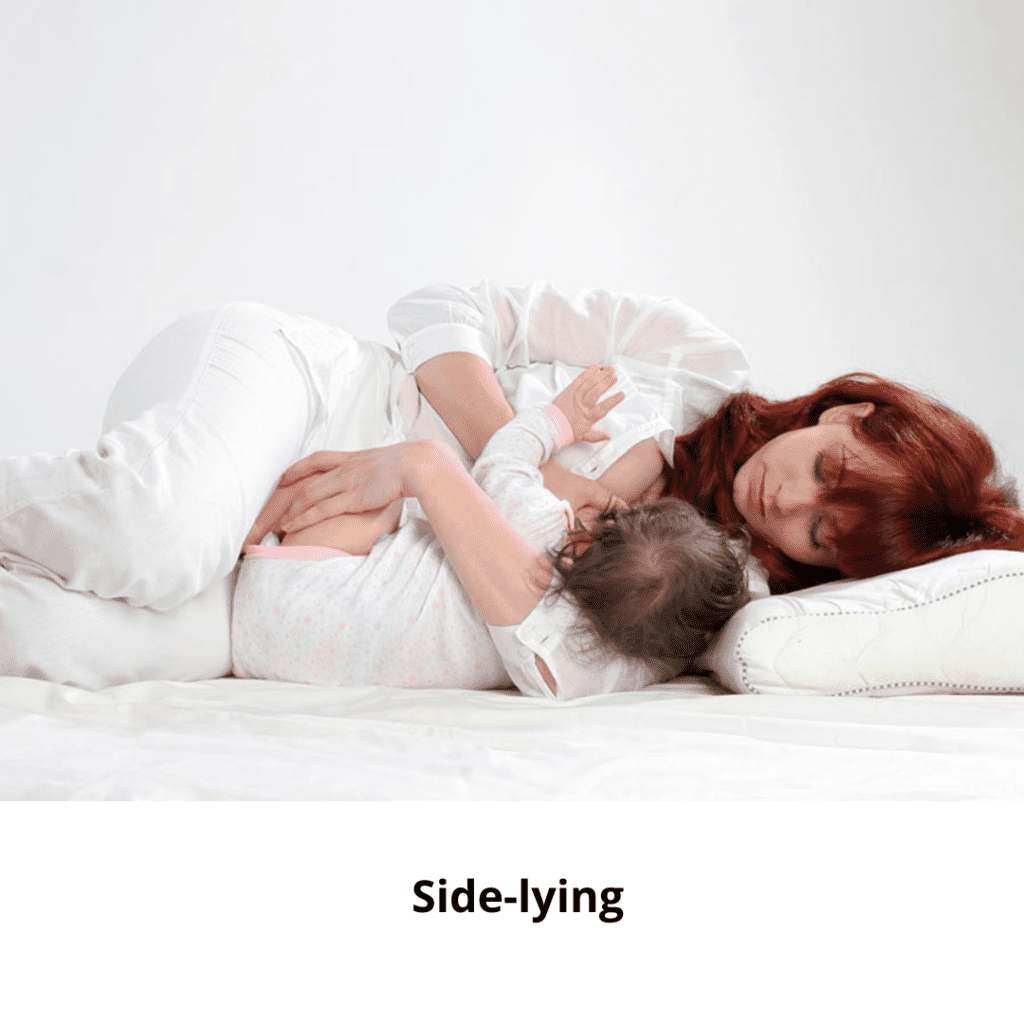
It is a perfect breastfeeding position if the mom is recuperating from surgery and for tired moms nursing at night. Moms who sleep with their babies can also benefit from this position. While some moms may find it difficult when they try this position at first, after a few tries they might not want to try some other positions.
To master this style:
- Face the baby when lying on one side
- Position the baby so their nose is close to the nipple
- Keep the baby close and support their back with your lower arm
While some babies find it easier to feed on the top breast, others might find it easier to nurse from the breast closer to the bed.
Please Note: While sleeping with the baby is quite popular, some doctors don’t recommend it. The reason behind it is that newborns might suffocate and some newborns have sudden infant death syndrome (SIDS).
The safest way to use this position is to remove all the pillows and blankets that are near the baby. Return the baby to their crib before falling asleep.
6. Clutch or Football Hold

This is an ideal position for moms that are recuperating from pain after childbirth or abdominal surgery. Also, this position is ideal for moms who have twins and want to nurse them simultaneously.
Many moms find that this position helps babies find a deeper latch. It is also known as a football hold as moms have to hold the baby like a football.
To use this position:
- Put a pillow on one or both sides of your body. Both sides are helpful if you are nursing two babies at a time. The pillows are to support the baby’s body.
- Keep the baby’s face upwards with their head close to your breast
- Align their neck, head, and back and keep them in position with your hand or arm
- Pull the baby close to you and tuck their legs under your arm
Tips for Breastfeeding
For a comfortable breastfeeding session, positioning is one of the most important aspects. Follow these tips for better and more effective breastfeeding sessions:
- Using pillows for extra support: You can use rolled blankets as well for this tip and it can be helpful because holding a baby for a long time strains your muscles. For instance, if you want to reduce neck and shoulder tension, place a pillow under your elbow.
- Creating a cozy nursing area: Choose a place in your home for the breastfeeding sessions and stock that place with snacks, a nursing pillow, water, burping supplies, a blanket, a magazine or a book, or other things that make the room more comfortable.
- Relaxing the upper body: Some moms tense up their upper bodies mainly their shoulders and necks to support the weight of their babies. Try to relax these muscles or take the support of a pillow to relax.
- Supporting the breast: Based on the size of the breast or the position, it can cover the baby’s face. You can use the free hand to support the nursing breast to make the position more comfortable for you and the baby.
- Pumping after each nursing session: If you want to store breast milk for future nursing sessions, you can pump after each session. This empties the breasts, which is more comfortable for the mom. Some moms prefer to pump while the baby is feeding on others to save time.
Techniques For a Good Latch
When it comes to breastfeeding, a good latch is very important. It makes sure that the baby is nursing properly by removing the milk from the breast and at the same time, it is comfortable for you.
A good latch usually means that the baby’s mouth is open and snug against the nipple. It doesn’t matter how the latch looks, but it matters how it feels and whether the baby is nursing properly or not. Below are some tips for a good latch:
Support Your Breast
At first, holding and supporting your breast can be very helpful for the baby. You can use your free hand to form a C-shape by cupping your breast. Also, you can shape your breast into a ‘sandwich’ by using your finger to gently press down your nipples.
Support Your Baby
Support your baby by holding them belly to belly and ensuring that their head is facing toward your breast. You can also pull them toward you by positioning your arm across their back and holding their neck and back with your palms or fingers.
But, don’t put too much pressure on the back of their head. The baby should be able to move its neck and head freely so it can get into the best suckling position. Putting the baby into a “nose to nipple” position and having them figure out to come up from below and latch on can also be really helpful.
Is it supposed to hurt?
Breastfeeding shouldn’t hurt when the baby is well latched. But, it is common for the mom to feel a little tenser as they are learning to breastfeed. Moms can also feel some soreness for the first few seconds but it usually subsides. The soreness doesn’t remain during the feed and between feedings.
If your nipple is bleeding or cracked, it means that the latch isn’t deep enough. Try to get more breasts into the baby’s mouth so that the nipple is further in their throat.
Summary
For new moms, it is important to note that breastfeeding positions change with time as the baby develops in size. You can develop a routine but it may change after a few months. Therefore, be open to experimenting with different breastfeeding positions. Some positions might feel awkward in the beginning, but with practice, they will get easier and more comfortable.
Even after trying everything, you and the baby are experiencing trouble with breastfeeding, you should seek help. Usually, the problems can be solved at home, but if you wait too long, both you and the baby can get frustrated.









